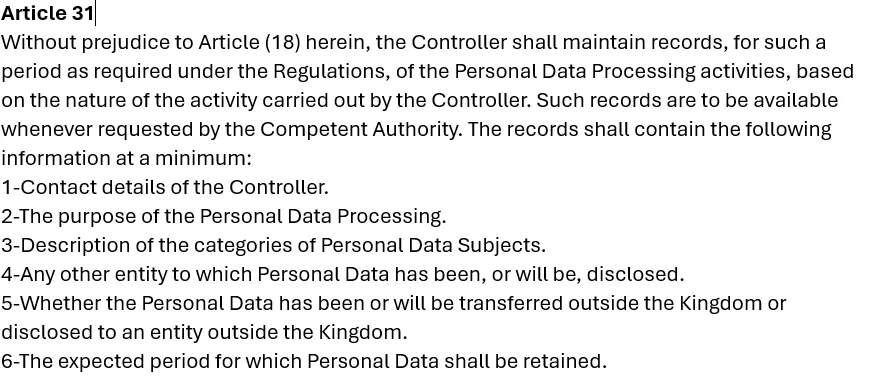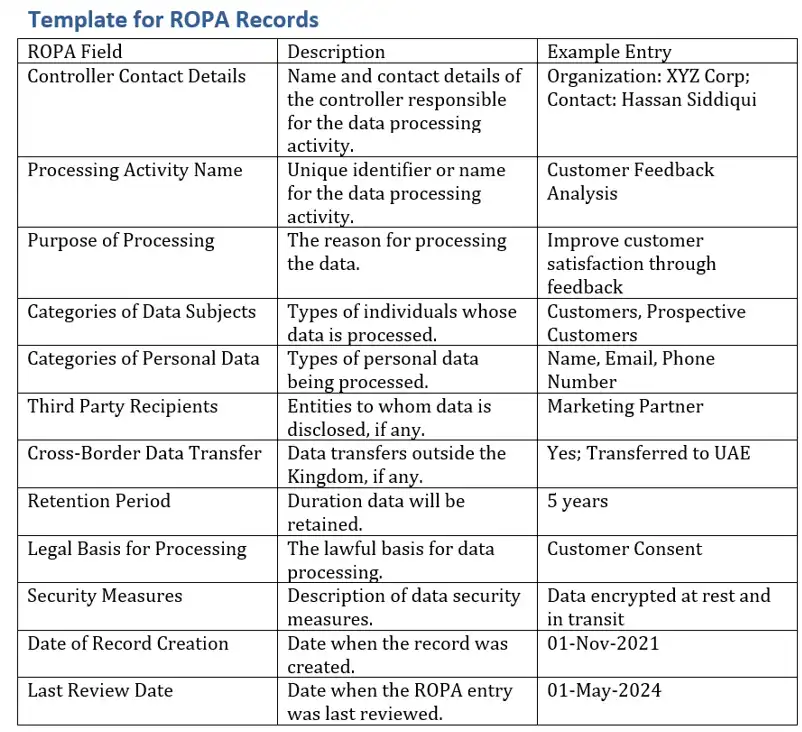
Abstract
This article provides an in-depth analysis of the compliance requirements under Article 31 of the Kingdom of Saudi Arabia’s Personal Data Protection Law (KSA PDPL). Focusing on Record of Processing Activities (ROPA), this paper explains the importance of maintaining accurate records of personal data processing activities, allowing for organizational transparency and regulatory compliance. Controllers must ensure these records are updated and available for the Competent Authority’s audit as mandated.
Keywords
ROPA; Controller; Personal Data Processing; Data Retention; Compliance; KSA PDPL; Data Subject Categories; Data Governance.
Introduction
The KSA PDPL establishes the legal framework for personal data protection in Saudi Arabia. Article 31 specifically mandates controllers to maintain Records of Processing Activities (ROPA), providing essential information about data processing, ensuring transparency, and accountability. ROPA helps in aligning data practices with regulatory standards.
Explanation
Article 31 of the KSA PDPL requires that controllers document personal data processing activities. This means maintaining records for every activity involving personal data to ensure compliance with legal obligations, promote transparency, and prepare for potential audits by the Competent Authority.
Detailed Discussion Of KSA PDPL – Article 31(ROPA)
The main components of ROPA under Article 31 include contact details, processing purposes, categories of data subjects, third-party disclosures, cross-border transfers, and data retention periods. Each component ensures that data controllers are transparent in their operations and comply with KSA regulations.
- Expand on each of Article 31’s core ROPA requirements:
- Contact Details of the Controller: Highlight the need for accessible contacts within the organization for external queries and internal compliance checks.
- Purpose of Processing: Emphasize the importance of documenting the purpose for processing each dataset as it supports accountability and auditing.
- Categories of Data Subjects: Explain why categorizing data subjects (e.g., customers, employees) ensures better tracking and targeted compliance.
- Disclosure to Third Parties: Detail the significance of recording any third-party disclosures, especially if personal data is shared outside the Kingdom, to ensure proper regulatory oversight.
- Cross-Border Transfers: Analyze the importance of logging instances when data is transferred out of the Kingdom, a major compliance requirement.
- Retention Periods: Describe how retention periods ensure that data is kept only as long as necessary and then safely disposed of, an essential aspect of data lifecycle management.
Key Strategic Points Of KSA PDPL – Article 31 (ROPA)
- List strategic actions for controllers to ensure ongoing compliance with Article 31:
- Establishing a centralized ROPA to document all data processing activities.
- Setting up review processes to update ROPA as new processing activities are added or existing ones change. To achieve compliance with Article 31, controllers should focus on creating a centralized ROPA and establish periodic review processes.
- Conducting regular audits of ROPA records to verify accuracy and completeness.
General Activation Steps
- Outline the steps for implementing ROPA:
- Catalog Processing Activities: Identify all activities that involve processing personal data within the organization.
- Implement Data Mapping: Map out data flows and processing systems to support accurate ROPA documentation.
- Detail Each ROPA Component: Document each requirement under Article 31, ensuring the record includes contact details, processing purposes, data subject categories, and retention periods.
- Establish Review Protocols: Schedule regular reviews and updates to keep the ROPA records current.
- Prepare for Compliance Audits: Set protocols to ensure the ROPA is easily accessible and ready for audits by the Competent Authority.
Enablement Methodology
- Describe the tools and processes for ROPA enablement:
- Data Mapping Tools: Tools like Alation or Collibra can automate data flow mapping, essential for keeping the ROPA updated.
- Compliance Management Platforms: Systems like OneTrust allow tracking and centralizing data processing activities, facilitating ROPA documentation.
- Automated Update Alerts: Implement automated alerts for updates to data processing activities, ensuring the ROPA remains current.
Use Cases KSA PDPL – Article 31 (ROPA)
- Present examples of successful ROPA implementation:
- Example 1: A Saudi organization’s approach to setting up and maintaining ROPA, showcasing best practices in Article 31 compliance.
- Example 2: An international company’s experience in GDPR ROPA compliance, drawing parallels to Article 31 requirements.
Dependencies
- List dependencies for successful ROPA compliance:
- Cross-Functional Collaboration: Emphasize the need for cooperation between compliance, legal, IT, and business units.
- Data Governance Structure: Highlight the role of data governance in supporting ROPA and ongoing compliance.
- Training and Awareness Programs: Emphasize the importance of educating employees about ROPA and its role in data protection.
Tools/Technologies
- Recommend tools to assist with ROPA management:
- Compliance Tracking Systems: Use tools like TrustArc for managing and updating ROPA documentation.
- Data Management Platforms: Systems such as Informatica for cataloging data and tracking processing flows.
- Document Storage Solutions: Securely store ROPA records in document management systems, ensuring compliance.
Challenges & Risks KSA PDPL – Article 31 (ROPA)
- Challenges: The complexities of managing a large number of data processing activities, the need for frequent updates, and the resources required.
- Risks: The legal and operational risks of non-compliance, including fines, audits, and potential loss of trust.

Conclusion
ROPA, as mandated by Article 31 of KSA PDPL, serves as an essential tool for ensuring data processing transparency and accountability. Controllers are advised to maintain proper records to meet legal obligations and enable trust with regulatory authorities.
Recommended Resources
- Big Data vs. Traditional Data, Data Warehousing, AI, and Beyond
- Big Data Security, Privacy, and Protection, & Addressing the Challenges of Big Data
- Designing Big Data Infrastructure and Modeling
- Leveraging Big Data through NoSQL Databases
- Data Strategy vs. Data Platform Strategy
- ABAC – Attribute-Based Access Control
- Consequences of Personal Data Breaches
- KSA PDPL (Personal Data Protection Law) – Initial Framework
- KSA PDPL – Consent Not Mandatory
- KSA PDPL Article 4, 5, 6, 7, 8, 9, 10, 11, & 12
- KSA PDPL Article 13, 14, 15, 16, 17, 18, 19, 20, 21, 22, 23, 24, 25, 26, 27, 28, 29, & 30
- KSA NDMO – Data Catalog and Metadata
- KSA NDMO – Personal Data Protection – Initial Assessment
- KSA NDMO – DG Artifacts Control – Data Management Issue Tracking Register
- KSA NDMO – Personal Data Protection – PDP Plan, & PDP Training, Data Breach Notification
- KSA NDMO – Classification Process, Data Breach Management, & Data Subject Rights
- KSA NDMO – Privacy Notice and Consent Management
- Enterprise Architecture Governance & TOGAF – Components
- Enterprise Architecture & Architecture Framework
- TOGAF – ADM (Architecture Development Method) vs. Enterprise Continuum
- TOGAF – Architecture Content Framework
- TOGAF – ADM Features & Phases
- Data Security Standards
- Data Steward – Stewardship Activities
- Data Modeling – Metrics and Checklist
- How to Measure the Value of Data
- What is Content and Content Management?

